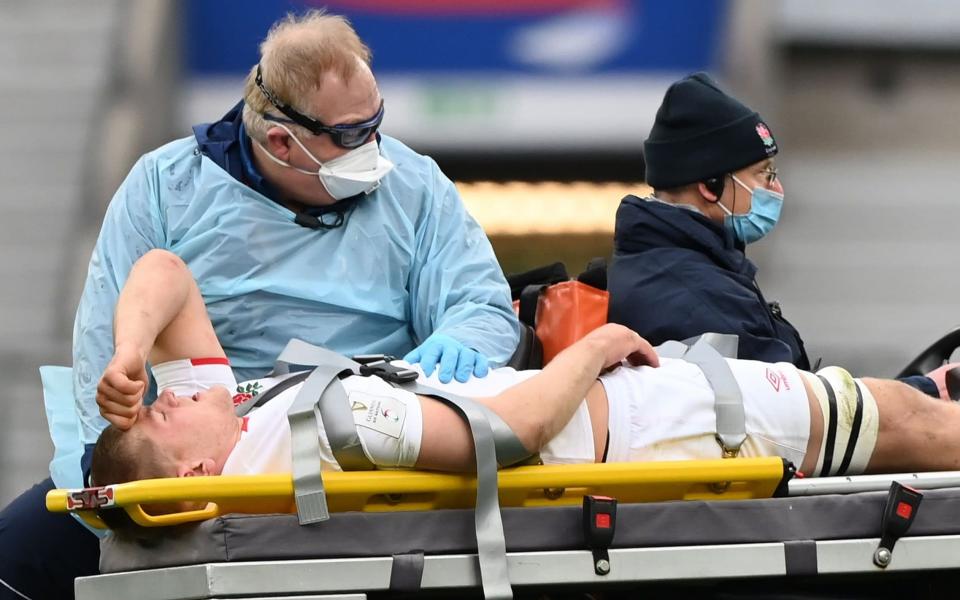Difficult to protect players but not jeopardise quality, says Jean de Villiers as Jack Willis vows to return stronger

Former South Africa captain Jean de Villiers says that he suffered “flashbacks” when he watched England flanker Jack Willis suffer his devastating knee injury against Italy.
There are certain memories that everyone likes to keep behind a locked door in their mind. For De Villiers that applies to the dislocated kneecap he suffered against Wales in November 2014. It remains one of the most gruesome acts of misfortune to have occurred in an international match. Witnesses recall his scream piercing through the white noise of nearly 60,000 people at the Principality Stadium.
Understandably, De Villiers says he does not like to think about it. Unfortunately watching the Six Nations on Saturday, De Villiers was presented no choice when he saw Willis suffer an injury in almost identical circumstances as he was “croc rolled” out out of a ruck.
“When I saw the injury occur, I certainly had flashbacks because there were so many similarities in the way that it happened and the pain that immediately occurs post that,” De Villiers said. “They are not happy memories. I just feel so bad for him because I know what he is going through and how long the road is to recovery. My thoughts are with him right now.”
Like Willis, De Villiers was jackalling for the ball when a combination of one man twisted him one way while the weight of other players collapsed on his prone leg. The injury may not have happened without the initial twist but De Villiers ascribes it far more to bad luck than any recklessness on the part of the Wales players.
“If I remember it correctly, I was cleaned out by Taulupe Faletau from my left hand side and as he cleared me quite low it straightened my left leg,” De Villiers said. “Then the weight came more side on and another two guys were cleaning from the right hand side. The two forces from both sides, I just could take the weight and everything collapsed. Sometimes in rugby, it is just the force plus the angle plus bad luck and you find yourself in a bad position.”


The damage was as bad as it comes. “I did my ACL, PCL, MCL, dislocated my patella, tore VMO muscle off and a hamstring,” De Villiers said before jokingly adding. “The rest of the knee was fine.” At one stage, he feared he would not walk again. As a result of previous knee operations, he needed artificial knee ligaments to be inserted. “I had run out of body parts,” he says. After six knee operations, he did return, which is nothing short of a miracle, playing just a handful of matches before suffering a dislocated jaw at the 2015 World Cup.
The scars remain. A video of De Villiers jiggling his kneecap around in its socket did the rounds on social media in 2019.
Warning: The below footage some readers may find distressing
“My party piece,” he says proudly. “I won’t say I suffer on a daily basis but I am restricted because of it. I can’t play a game of touch rugby with the kids for example.”
At least Willis escaped tearing his ACL even if his Wasps head coach Lee Blackett confirmed that he did “everything but that” in his left knee. The reigning Premiership player of the season said in a tweet yesterday:
I will give everything I can to my rehab to come back a better and stronger player. Thank you so much for all the messages and support I’ve received it really is appreciated.
I will be back 👊🏼💪🏼 pic.twitter.com/3ao0QU6cJ6— Jack Willis (@jackswillis7) February 15, 2021
De Villiers’ main advice for Willis, who previously spent the best part of a year on the sidelines, is to maintain a positive attitude and trust in the team around him. On the issue of the legality of “crocodile rolls”, De Villiers is phlegmatic. While he supports protecting player safety, there is no straightforward solution to policing the breakdown.
“In terms of clearing out and protecting the jackal, the head area is a no-go and rightly so,” De Villiers said. “Your target area has become so small in terms of clearing out a player that it is so easy to get it wrong whether it is a head contact or a crocodile roll. We want to protect players but how do you do that and not jeopardise quality of product? I don’t have answer to that. It is so difficult because there are so many variables. The player jackalling moves a couple of centimetres, gets it wrong and it can be a big injury.
The decisions that the governing body has to make on and off field are very, very difficult.”

